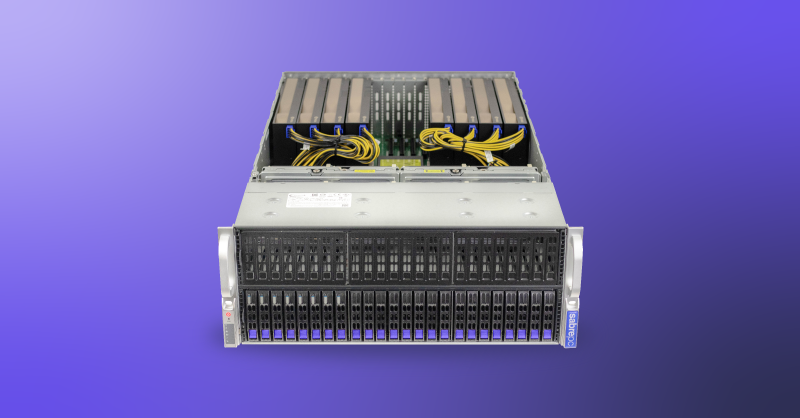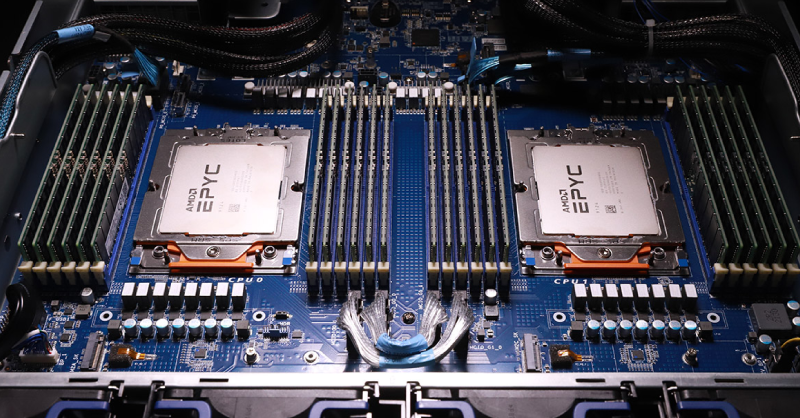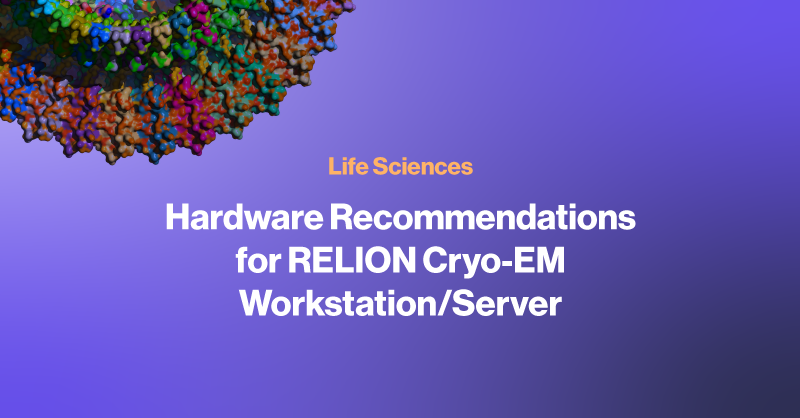Background on Cryo-EM
Cryo-EM or cryogenic electron microscopy is a specialized field of study in microbiology for capturing the structure of molecules. This is done by freezing a molecule a near absolute zero, firing electrons to take hundreds of 2D cross-section pictures of the structure, and aligning the 2D images to reconstruct a 3D image representation of the molecule.
SabrePC has delivered numerous purpose-built RELION for cryo-EM systems ranging from wet-lab multi-GPU workstations and remote 8 GPU servers to research institutions around the nation. We offers our expertise as a resource for you to build your dream system.
Most cryo-EM workloads are facilitated by RELION and CryoSPARC, both of which should have similar computing requirements. However, per our last hardware recommendation blog for molecular dynamics, it is important to consider all kinds of workloads this machine will tackle since you may also plan to run MD simulations on your new system when not in cryo-EM use.
The computing demands for running cryo-EM are quite substantial, necessitating a careful selection of hardware to ensure optimal performance. This blog aims to guide researchers and practitioners, and even students of the field, in the realm of microbiology by providing essential recommendations for building or upgrading a dedicated RELION for a cryo-EM workstation or server. The GPUs are the most impactful hardware in a cryo-EM system so let's start with that:
Best GPU for RELION Cryo-EM
The most popular GPUs for cryo-EM are mid and high-tier NVIDIA professional RTX GPUs with a large VRAM capacity, ample cores, and high clock speeds. If you plan to deploy your cryo-EM workloads on a workstation, for Molecular Dynamics, the RTX 4090 is excellent for the job, but we would recommend a multi-GPU system with 4x RTX 6000 Ada, RTX 5000 Ada, and maybe RTX 4500 Ada GPUs. Opting for a multi-GPU system can increase the total GPU memory capacity essential for executing cryo-EM workloads.
Sometimes, too much memory results in underutilized performance; for this reason, the SabrePC recommendation would be going with a 4x GPU setup with a mid-range professional RTX GPU such as the RTX 5000 (32GB each) or the RTX 4500 Ada (24GB each) GPU. These GPUs technically have fewer cores and clock speeds but are optimized for performance and cost and can save a pretty penny over the RTX 6000 Ada for a small performance sacrifice especially when being able to compute in parallel using multi-GPUs.
The only downside to using 4090s is the space within a workstation as mentioned above. Most workstations can comfortably fit one, maybe 2, RTX 4090 and cannot be used in a server, whereas the professional NVIDIA RTX Ada GPUs have a smaller, standardized double-wide footprint. For any of the NVIDIA professional RTX GPUs, these cards can be stacked back-to-back to up to 4x GPUs in a single workstation or 2U server.
Now the last thing to consider is what other software are you running. Since RELION and cryo-EM workloads are highly computationally intensive, any system running RELION should be able to run other molecular dynamics software.

Best CPU for RELION Cryo-EM
Cryo-EM workloads are not CPU intensive and mainly rely on GPU acceleration. Great all-around CPUs cryo-EM are the Intel Xeon-W, AMD Threadripper, Intel Xeon Scalable CPUs, and AMD EPYC processors. We feel any processors with 32 to 64 cores will be sufficient for most cryo-EM workloads with the main focus being the number of PCIe lanes available to use on a system. A good rule of thumb would be to allocate 4 cores per GPU plus an extra 4 more cores for scheduling tasks – let's say approximately 5 cores per GPU.
For example, if you are opting for a workstation setup with 4 GPUs – 5 cores per GPU x 4 GPUs = 20 cores –opt for a processor with at least 24 cores or choose 32 cores (since these are more popular). If your system is an 8 GPU server setup – 5 cores per GPU x 8 GPUs = 40 cores – opt for at least a single 48-core CPU or dual 24 cores. Going a little higher will not hurt, especially if you have other workloads that are CPU-dependent, so a 64-core CPU is a safe pick as an all-around processor.
The AMD Threadripper PRO and Intel Xeon W are great workstation options with ample PCIe lanes for the 4 GPUs and high-speed storage in a system. For servers, use a mid-range Intel Xeon Scalable and AMD EPYC. If you want additional CPU memory, opt for a low core high clock speed dual CPU setup that also satisfies your GPU preference.
The main difference between a workstation CPU and a server CPU is the RAM capacity, PCIe lanes, and dual processor configurations. If your budget permits, opting for a workstation CPU over a desktop CPU can mean more memory and options for up to 4x GPUs for maximum performance or accelerators for multiple jobs. With additional budgeting and a space to store your compute node and storage node, a compute server can increase the maximum RAM and additional GPUs and utilize a dedicated storage node for storing cryo-EM 2D image classifications and 3D reconstructed molecules. Just remember to spec into high-speed networking.
While ample cores are no doubt important, the clock speed of the processor is the star, as a higher clock means more instructions cycle that the CPU can deliver to other components of the system. If you choose a processor with too many cores (like the newest 96-core Threadripper PRO 7995WX), some of those cores can be left unutilized.

All these considerations and factors can get jumbled up and hard to track. But at SabrePC we custom configure the system for you! Tell us your workload, your hardware preferences, and goals and we will deliver you your dream system that works right out of the box. Check out our RELION platforms here.
Storage & Memory/RAM for RELION Cryo-EM
For most cryo-EM workloads in RELION ample CPU memory is always important to have, or you run the risk of bottlenecking at the memory level. Our recommendation would be to populate all DIMM slots for a total of at least the GPU VRAM capacity - if you go workstation with 4x RTX 6000 Ada, opt to slot your 8 DIMMs with 32GB sticks of RAM (198GB VRAM to 256GB CPU RAM).
Ample RAM is important for locally storing the 3D representation of your molecule without having to access data from storage constantly. More memory means better buffering for fast 3D reconstruction.
Speaking of storage, opt for large-capacity NVMe storage. For workstations, M.2 NVMe SSDs become very accessible and affordable per GB. For servers, the enterprise-grade U.2 NVMe SSD is still quite pricey but ensures safe provisioning and long life. We recommend at least a 2TB NVMe SSD, with more always being better.
Closing Thoughts
As a recap, for CPUs, we recommend a 32 to 64-core Intel Xeon W-3400 or AMD Threadripper PRO for workstations and middle-tier AMD EPYCs and Intel Xeon Scalables for servers. Our GPU recommendations we would suggest one (or two) RTX 4090 for those looking to spend as little as possible for the best performance in a workstation. If you want more parallel processing, 4x RTX 6000/5000/4500 Ada in the same workstation or deployed in a server depending on budget and computing goals. And for our Memory Recommendations, at least enough RAM to match the GPU VRAM.
Talking about CPU, GPU, and Memory are the main components in building a system. You’ll still need an appropriate power supply, a well-equipped cooling solution, storage (which we recommend 2TB- 4TB of NVMe storage), and a good case/server chassis to fit it all into.
But at SabrePC, when you purchase a custom system with us, we handle all those things for you so you can ensure the system you get in the mail is truly your dream system. All you need to do is plug it in press the power button, and start running.
Want to spec a workstation or system with us? Explore our workstations and server platforms for RELION cryo-EM, fill out a Contact Us form on the platform you like, or talk to us today!


